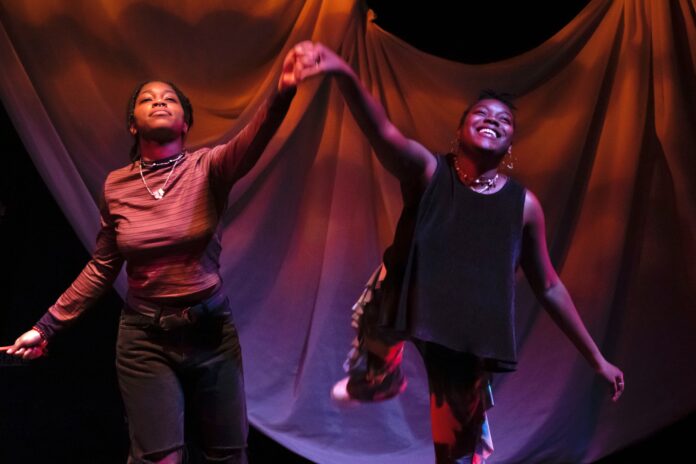Human emotion is extremely vulnerable and to see it brought to life onstage can be both rewarding and challenging.
The first Assembly performance since spring break, “A Feeling Of, Feeling For,” utilized human emotion to reward the actors and audience members alike. People were invited to hear these stories and experience these rituals of everyday life, loss, love and more. The piece was directed by Maereg Gebretekle ‘22 and the entire cast contributed to the development of the piece, since it was a devised production. This devised process can also be seen with a previous Assembly performance, “You are Cordially Invited.”
The ensemble consisted of Sidney Caruth ‘23, Tomomi Lewis-Noguchi ‘24, Elizabeth Muriel ‘23, Desiree Oliver ‘25, Alexa Sage ‘24, Celeste Samson ‘23, Dondrea Wynter ‘24 and they shared in the human and emotional experience of loss and ritual.
Muriel mentioned, “‘A Feeling Of’ was genuinely one of the most pleasant devising experiences I have had in my theatrical experiences here! Maereg and our stage management team, SM Eden [Kaufman ‘23] and ASM Emma [Walter ‘24] were wonderful to work with and the rest of the cast was truly so talented and generous with their art. It was so much fun to create with them. Each member of the ensemble showcased their own story to stand out from the ensemble while continuing to be in conversation with one another.”
“I focused on creating a story and it ended up coming together.”
– Celeste Samson ‘23
The program highlighted, “As you watch these stories, please be mindful that they are not supposed to be in chronological order. You are witnessing snippets of the past that the ensemble members experienced in their lives.”
The process of creating stories allowed for freedom from the performers and the ability to connect with others while being personal and honest.
“The cool thing about stuff like this is that people will take away whatever they need to from your art, so there’s no point in needlessly oversharing. I focused on creating a story and it ended up coming together,” Samson stated.
“Working on ‘A Feeling Of, Feeling For’ was an amazing experience,” claimed Caruth.
“There was a safe space created where the ensemble was able to be vulnerable with one another and tell stories of a moment, or moments in our lives where we had experienced a form of loss. We were also able to discuss any rituals that we did in our daily lives and what that meant for us as well,” continued Caruth.
The props were each representations of the distinct story and experience of each of the ensemble members. Beyond the representation of wonder with toys and plush animals, the props included a computer and a purple Squishmallow, but the constant prop was poppies.
“The red flowers were poppies, which represent different things to different cultures. In western cultures it symbolizes death and remembrance, and in eastern cultures it symbolizes love and success. The symbolism there for us as a cast was loss but also the growth that may come from loss,” stated Muriel.
These poppies could be seen throughout the stage and also played a hand in the experience for each of the ensemble members in connecting each story. The shared experience was much more than just flowers as each of the seven stories ended with a poem that was adapted to represent each performer’s identity.
“Our shared text (poem) was incorporated as a part of our collective ritual. Saying the poem, receiving a flower and releasing it into the well. The poem was chosen by Maereg. We all really liked it, and we were able to adapt it to our identities,” stated Caruth.
The ending line of the shared poem was, “Come celebrate with me that everyday something tried to kill me and has failed.”
The props were just one of the several technical elements of the piece that added to the experience of sharing these stories and in elevating these experiences. The Studio Theatre, Muhlenberg’s black box, was adorned with white fabric draping from the gallery down to the stage.
Nico Bittker ‘22 brought Caruth’s story, in addition to the rest of the ensemble, to life with those of lighting design.
Caruth mentioned, “Light in my story was powered by the bodies seen on stage and was affected by mood and movement. Everyone seen in my story was considered light. I was a yellow light, Celeste Samson’22 was a blue light, and when we came together for our meeting, we created green light which was then reflected again in my final prayer of thanks and appreciation.”
These elements also helped to highlight the audience and involve their own stories as well. After each of the seven stories, the performer wrote on a piece of paper something they wanted to let go of. The paper was then dropped into a small well with real water.
“I hope audiences walked away from the piece seeing how much can come from loss and what can come from giving students a platform to create art that is meaningful to them together.”
– Elizabeth Muriel ‘23
“I hope audiences walked away from the piece seeing how much can come from loss and what can come from giving students a platform to create art that is meaningful to them together. Having such a diverse cast and such a safe space really made this piece special to me,” stated Muriel.
Following the conclusion of the show, audience members were invited to let go of whatever they needed to. The wishing well was the most important element of the performance, allowing for everyone to let go of something they need to.
“The idea of expressing and then releasing loss as a collective was extremely powerful, and offering the same opportunity to the audience was so engaging,” stated Gabi McCabe ‘24, an audience member.
The performance allowed for everyone to share loss and to connect with others while understanding their individual value.
“Even if they didn’t relate to the specifics I hope people took away that they are deserving of patience and kindness no matter what stage of life they’re at. Sometimes it takes people a little longer than they think it will to get where they’re going, and there’s no harm in that,” declared Samson.
Johnny '24 is a Theatre and Media and Communication double major at 'Berg. He loves to highlight the voices of artists across campus and to showcase the wide variety of events at Muhlenberg. He likes to think he is funny, but that is up for debate.























